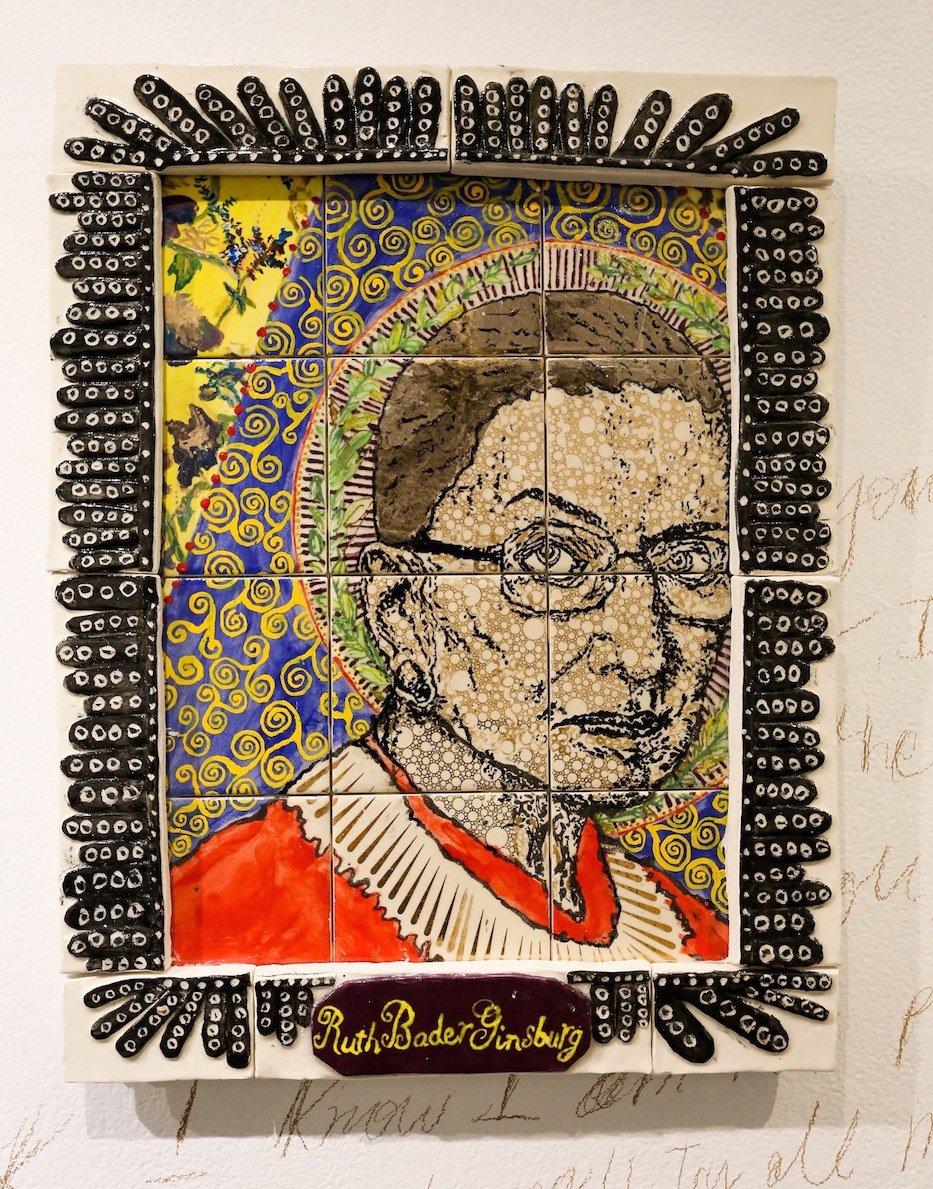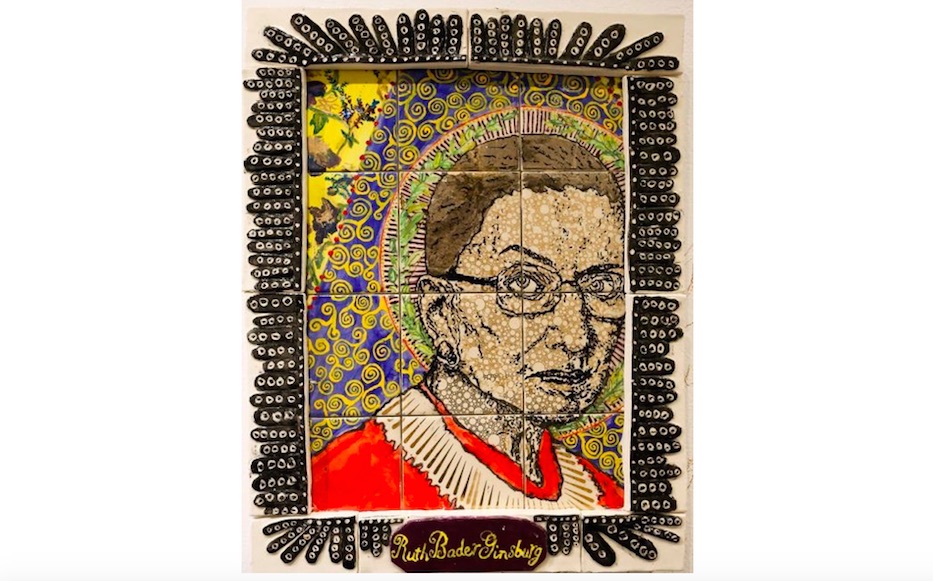
Long Wharf Theatre | Politics | Arts & Culture | COVID-19 | SCOTUS Theatre

Scene one. It is 2013, in the sticky heat of a D.C. summer. U.S. Supreme Court Justice Ruth Bader Ginsburg walks into President Barack Obama’s private dining room, where the table is set. Somewhere between the salad and the rolls, he brings up the 2014 midterm elections. He tiptoes, but she gets the point. He’s wondering if she should retire. She doesn't have any plans to do so, she tells him.
Did she endanger her legacy by making that decision?
A panel of legal scholars, artists and activists weighed in on that pivotal moment Thursday night, during a remote discussion on Ginsburg’s life and legacy from Long Wharf Theatre in New Haven and SCOTUS Theater in Northern California. Titled “All Rise,” the discussion jumped from Ginsburg’s early career with the American Civil Liberties Union to her landmark decisions in Reed v. Reed and Whole Woman's Health v. Hellerstedt to her ostensible blind spots on Black, trans, and Indigenous rights.
Ginsburg, who reached iconic status as “The Notorious RBG” in the last decade of her life, died last month at 87 years old. The discussion came after the confirmation of Amy Coney Barrett to the Supreme Court late Monday evening.
It was moderated by Lisa Stern, who co-founded SCOTUS Theater in 2016 with Liza Fuentes, Anu Gomez, and Becca Wolff. Panelists included Rewire News Editor and podcaster Imani Gandy, CUNY Law Professor Cynthia Soohoo, Yale Law Professor Judith Resnik and Quinnipiac University Law Professor and Dean Kevin Barry.
“I’m curious what you all make of this,” Stern said. “It has struck me as a kind of strange question to be asking—whether she should have foretold the future and known all of [Mitch] McConnell’s tactics and the fact that the 2016 election could have gone the way it did.”
While the discussion was rooted in Ginsburg’s long career, that question conjured the same high-stakes drama and snappy dialogue that one might see in a script. Gandy, who anchors the Boom! Lawyered podcast through Rewire, was the first to jump in.
She recalled how absurd she found the image of a group of men taking the justice out to lunch and politely trying to convince her to retire, even as Justice Stephen Breyer neared his eighth decade of life (he is now 82; Ginsburg was 87). She pointed to the fact that Ginsburg recognized those stakes—and also saw staying on the court as part of her direct ability to make an impact.
From her three years as the only woman on the court, Ginsburg also knew how deeply Sandra Day O'Connor regretted stepping down in 2006, a decision that she made to care for her ailing husband. Gandy noted that Ginsburg also wouldn’t have wanted a moderate to replace her—not a Merrick Garland, and certainly not an Amy Coney Barrett—and couldn’t have predicted the 2016 election of President Donald Trump.
“Ruth Bader Ginsburg worked until she literally died,” she said. “Imagine working until you expire. And so now people are coming back and saying ‘oh, well she should have done this and should have done that’ when she worked not for herself, it wasn’t ego. I’ve seen people saying ‘Oh this is just an ego trip.’ This wasn’t ego! This was her trying to leave a better world for people. And I don’t think that she would have thought leaving a better world would have meant being replaced by like a white centrist.”
Resnik added that Ginsburg saw and understood the value of female mentorship. She pointed to the significance of her tenure on the court alongside Justices Elena Kagan and Sonia Sotomayor, both Obama appointees who joined her after Ginsburg’s three years as the only woman on the bench from 2006 to 2009.
“Having been in many rooms where I’m the only woman … her contribution to Justices Kagan and Sotomayor for being inside that room and being there,” she said. “She used to talk about—you know, the bench was hardly parity in her lifetime. So I think that’s another facet of the contribution that has already been laid out.”
“Women mentor each other in ways where they don’t even know that that’s what they’re doing,” Gandy added, adding that the Twitterverse had eviscerated her for suggesting that the two younger justices had learned from Ginsburg’s leadership and understanding of the law.
She recalled that during her third year as a law student, she learned to play golf for the explicit purpose of not being excluded from the conversations that her white, male peers were having on the course.
“So I think that this idea of mentorship, this idea that Ginsburg would have left the bench as soon as these two women were coming on the bench—I think that’s a really weird thing to expect her to do,” she said.
That wasn’t just symbolically important, Soohoo added. When decisions that directly addressed or impacted women’s health came before the Supreme Court, Ginsburg was one of two, and later three voices to provide not only far-reaching, often international legal precedent, but also lived experience. While she held concerns during her lifetime that Roe v. Wade made itself vulnerable because of its sweeping nature—a prediction that may turn out to be true under Barrett—she was a champion of women’s health and reproductive freedom during her time on the bench.
Soohoo remembered listening to the 2015 oral argument for Whole Woman's Health v. Hellerstedt, in which five justices ultimately ruled that Texas House Bill 2 (H.B. 2) was unconstitutional (Justices Roberts, Thomas and Alito dissented). In 2013, the Texas bill introduced significant TRAP (targeted regulation of abortion providers) legislation under the guise of women’s health and safety. It came just three years before Mike Pence passed Indiana’s HEA 1337, a bill with some of the most restrictive anti-abortion measures to date.
“All these assertions were made about the nature of the procedure,” she said. “You know, what abortion is, sort of all this innuendo, and vague things stigmatizing abortion and claiming that it was dangerous. And just one by one—just having women on the court who could talk about ‘well, isn’t this the same as a d&c [dilation and curettage]? You know, what is this procedure really like? And that never would have happened if you didn’t have three women in the room who were familiar with the procedure, who could bring women’s experiences into it, and were truth-tellers.”
Soohoo compared the 2015 oral argument to the 1980 decision in Harris v. McRae, in which an all-male bench decided that states could effectively decide whether Medicaid funding and reimbursement extended to medically necessary abortions.
“They were going to say there was some ridiculous health reason, and a lot of the male justices would just go along and sort of say ‘well, there must be some reason,’ when in act it really didn’t make sense,” she said. “And if you understood the way the procedure actually works and you understood women’s reality in the ability to get to clinics, it just made so much difference having those three women in the room.”
That now-imbalanced bench could be a reason to pack the courts under a new presidential administration, panelists concluded. Resnik reminded the group that the limit of nine people isn’t written anywhere in the Constitution, pointing to a New York Times op-ed that advocated for sweeping changes to the Supreme Court.
Barry noted that there need to be fewer people who look like him—he is a white man—and think to the right of center. Gandy suggested a court of 30 justices, noting that the court now has six justices who have curried favor with the Federalist Society.
“We need to go move to a time when there’s a diversity of thought, so that there’s not always going to be the rights of people—same-sex marriage, voting rights, abortion rights, criminal justice, climate change—all those rights shouldn’t sit on whether or not John Roberts has a good lunc, or whether or not Neil Gorsuch has a good night’s sleep. There should be more people actually discussing rights that actually affect human beings.”

